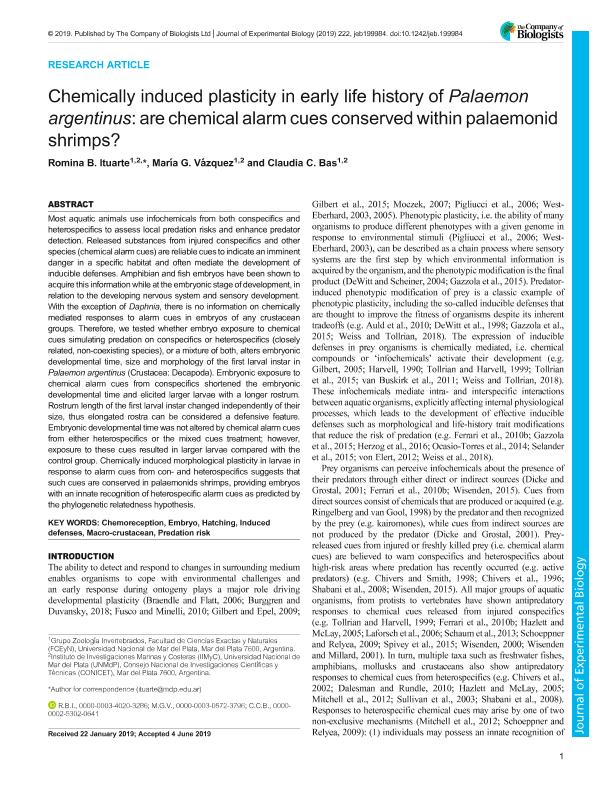Artículo
Chemically induced plasticity in early life history of Palaemon argentinus: Are chemical alarm cues conserved within palaemonid shrimps?
Fecha de publicación:
06/2019
Editorial:
Company of Biologists
Revista:
Journal of Experimental Biology
ISSN:
0022-0949
Idioma:
Inglés
Tipo de recurso:
Artículo publicado
Clasificación temática:
Resumen
Most aquatic animals use infochemicals from both conspecifics and heterospecifics to assess local predation risks and enhance predator detection. Released substances from injured conspecifics and other species (chemical alarm cues) are reliable cues to indicate an imminent danger in a specific habitat and often mediate the development of inducible defenses. Amphibian and fish embryos have been shown to acquire this information while at the embryonic stage of development, in relation to the developing nervous system and sensory development. With the exception of Daphnia, there is no information on chemically mediated responses to alarm cues in embryos of any crustacean groups. Therefore, we tested whether embryo exposure to chemical cues simulating predation on conspecifics or heterospecifics (closely related, non-coexisting species), or a mixture of both, alters embryonic developmental time, size and morphology of the first larval instar in Palaemon argentinus (Crustacea: Decapoda). Embryonic exposure to chemical alarm cues from conspecifics shortened the embryonic developmental time and elicited larger larvae with a longer rostrum. Rostrum length of the first larval instar changed independently of their size, thus elongated rostra can be considered a defensive feature. Embryonic developmental time was not altered by chemical alarm cues from either heterospecifics or the mixed cues treatment; however, exposure to these cues resulted in larger larvae compared with the control group. Chemically induced morphological plasticity in larvae in response to alarm cues from con- and heterospecifics suggests that such cues are conserved in palaemonids shrimps, providing embryos with an innate recognition of heterospecific alarm cues as predicted by the phylogenetic relatedness hypothesis.
Archivos asociados
Licencia
Identificadores
Colecciones
Articulos(IIMYC)
Articulos de INSTITUTO DE INVESTIGACIONES MARINAS Y COSTERAS
Articulos de INSTITUTO DE INVESTIGACIONES MARINAS Y COSTERAS
Citación
Ituarte, Romina Belen; Vázquez, María Guadalupe; Bas, Claudia Cristina; Chemically induced plasticity in early life history of Palaemon argentinus: Are chemical alarm cues conserved within palaemonid shrimps?; Company of Biologists; Journal of Experimental Biology; 222; 13; 6-2019; 1-8
Compartir
Altmétricas




